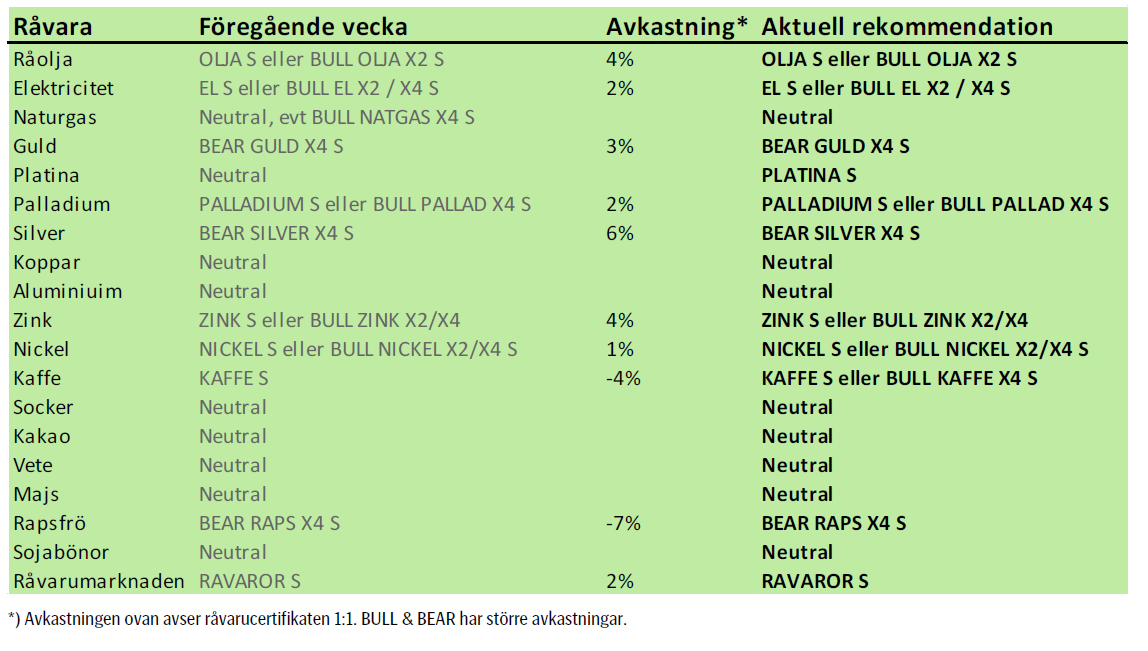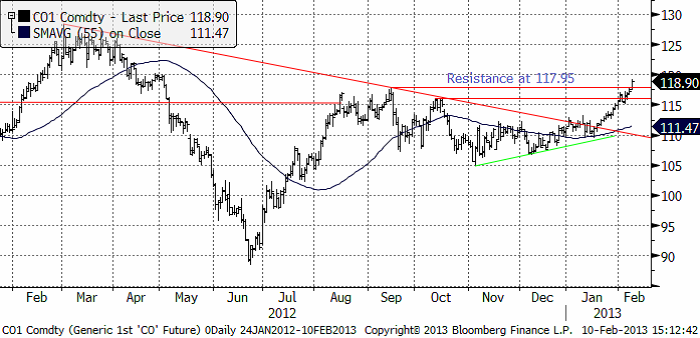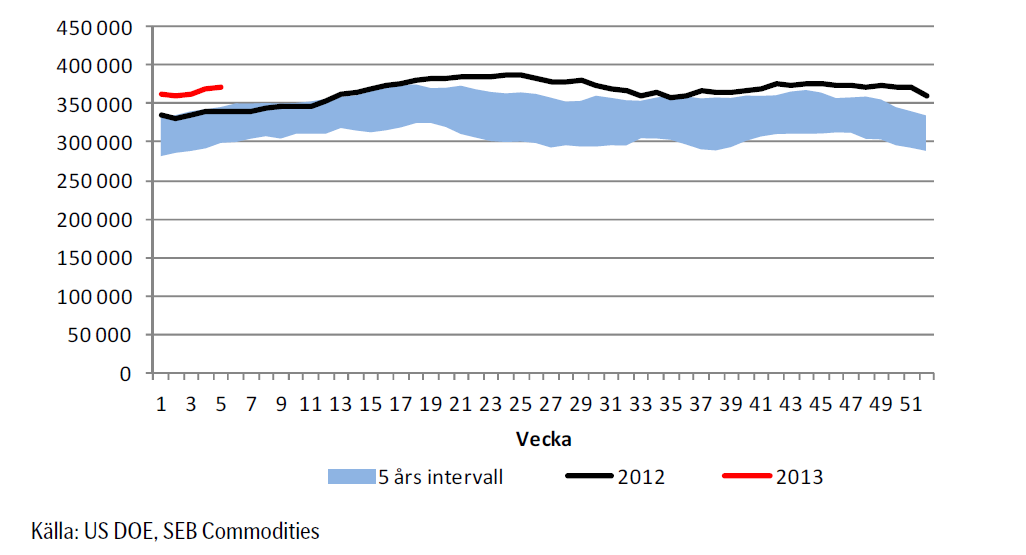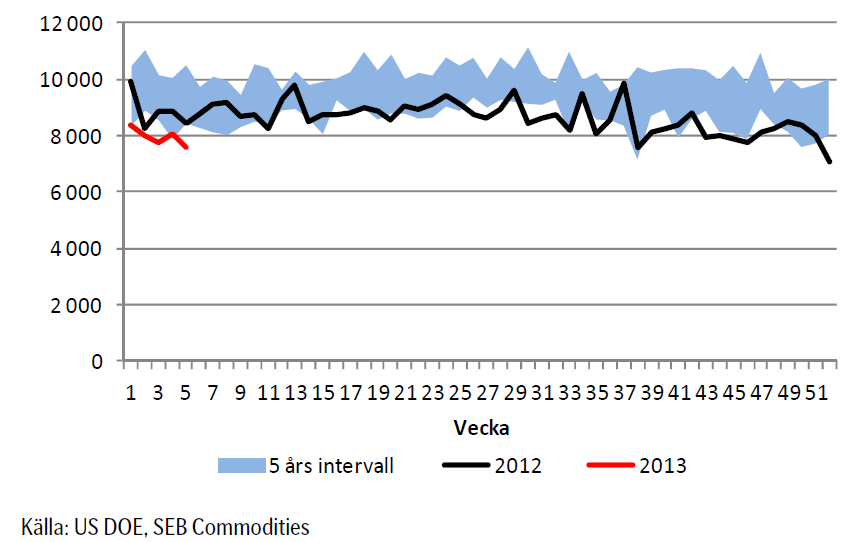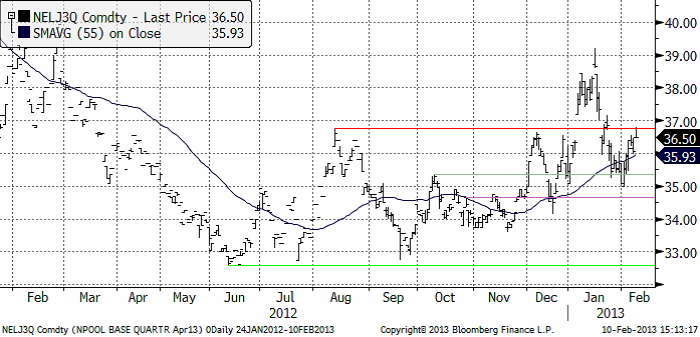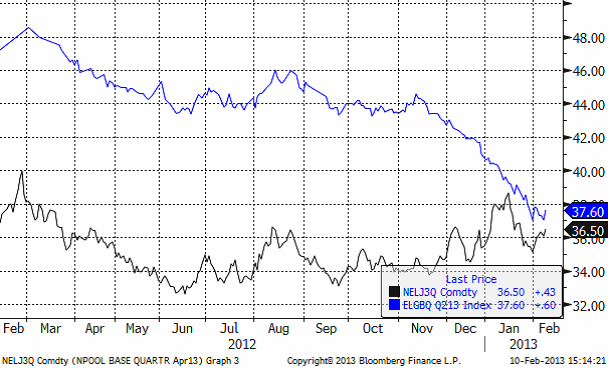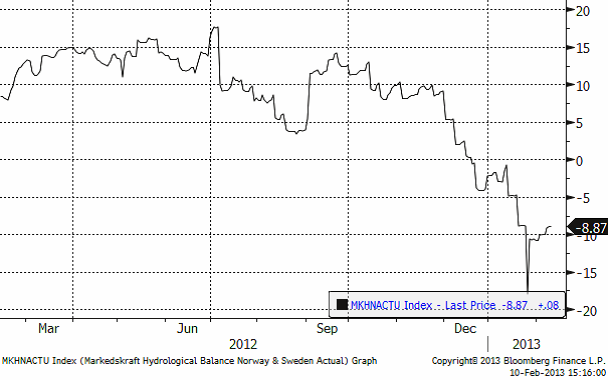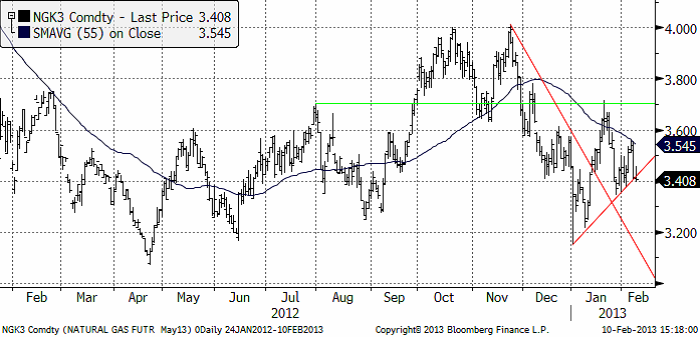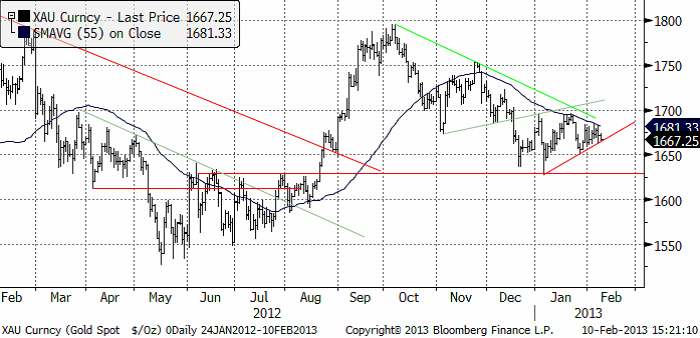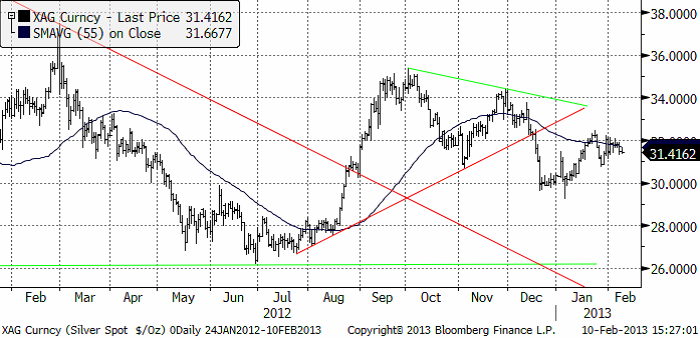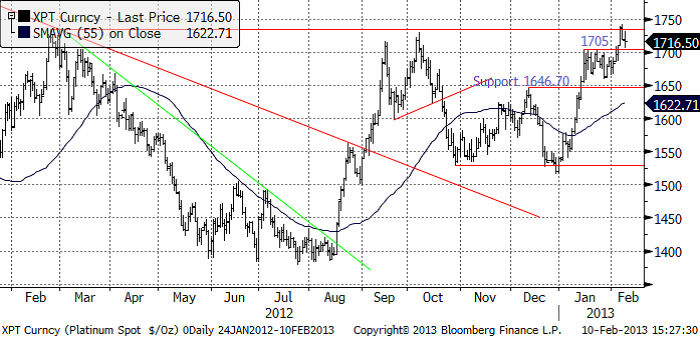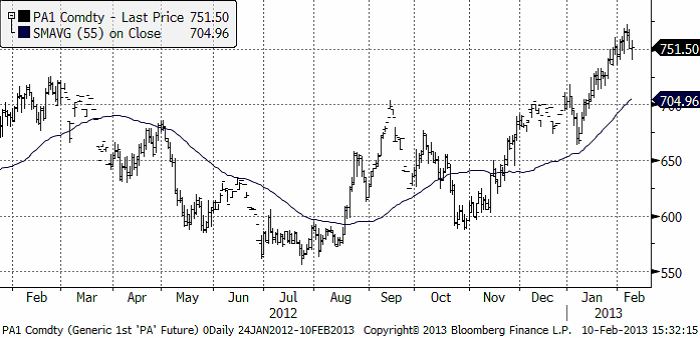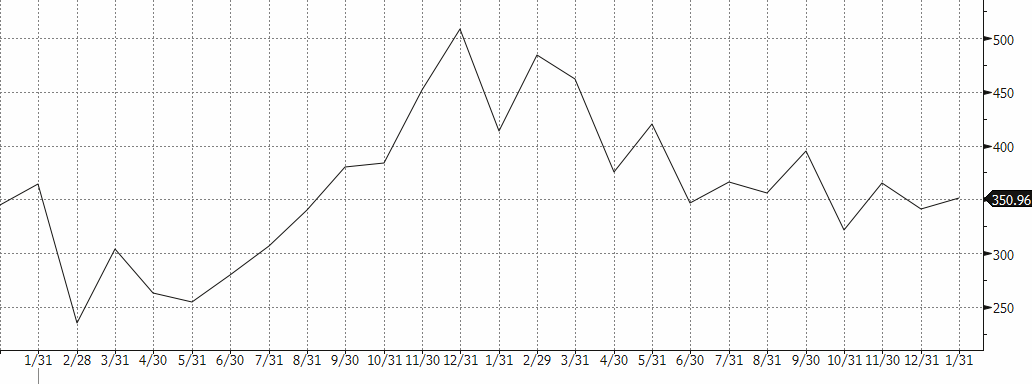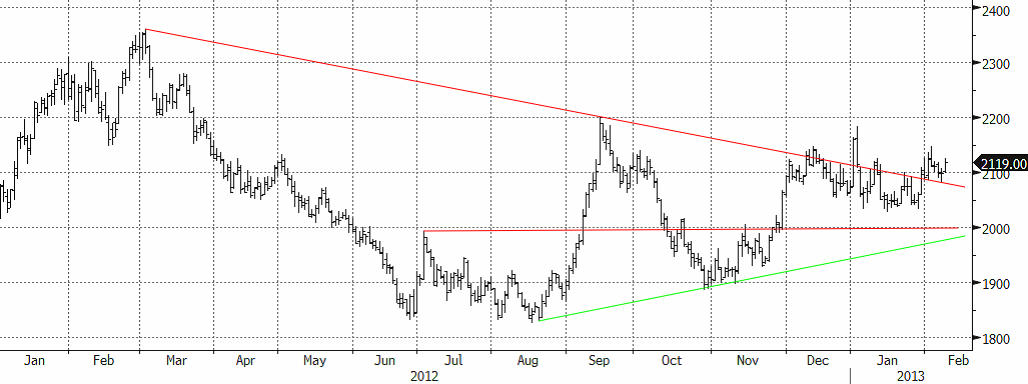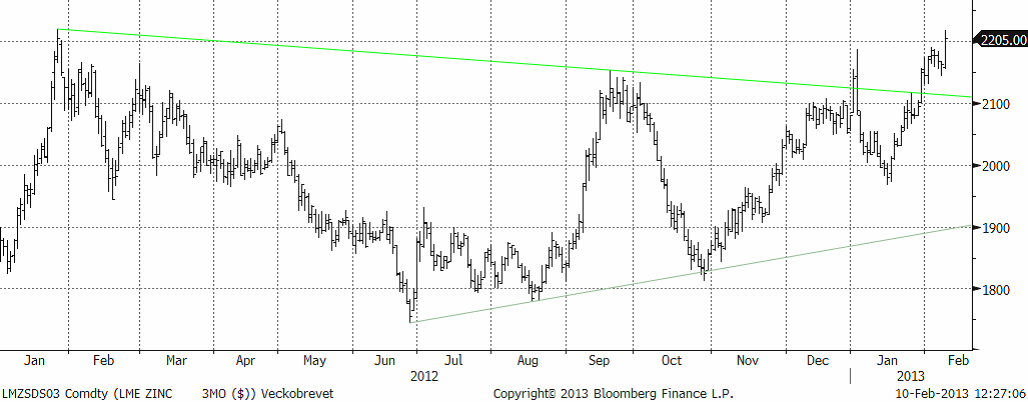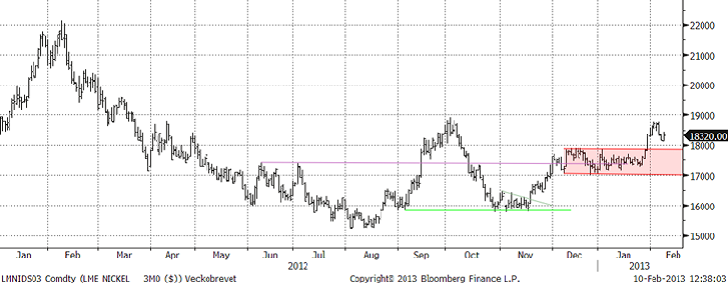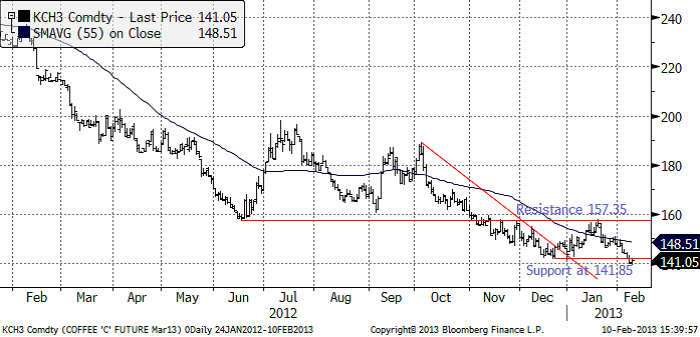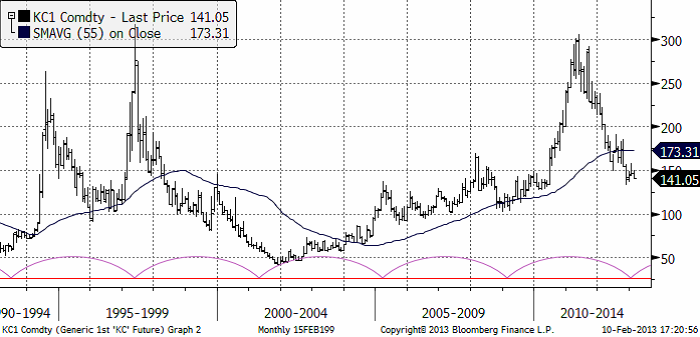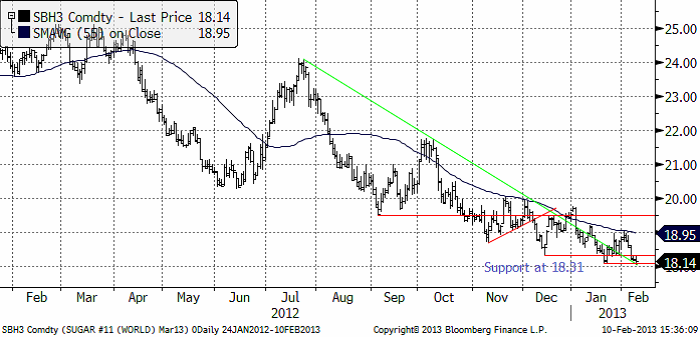Analys
SEB – Råvarukommentarer, 11 februari 2013

Rekommendationer
Inledning
Råvaruindex i svenska kronor steg med 2%, vilket medförde att råvaruindex-certifikatet RAVAROR S steg lika mycket. Aktiemarknaden hade däremot en blandad vecka, där i synnerhet råvarubolaget SSAB:s rapport fick aktien på fall. Råvaror och aktier är inte samma sak, som bekant.
Oljepriset fortsatte att stiga med stöd av tecken på en starkare konjunktur i kombination med att produktionen kortsiktigt stryps av Saudiarabien och på grund av hoten om våld även i Algeriet och Libyen.
Som väntat steg elpriset på Nordpool, vilket fick BULL EL X4 S att stiga med 9% på en vecka. Vi tror att det kan komma en rekyl nedåt, men i ett större perspektiv verkar det som om elpriserna håller på att förbereda sig för en fas av prisuppgång. Såväl marknaden för kol, som utsläppsrätter stärktes i veckan som gick; under stöd av starkare global konjunktur.
I fredags publicerade USDA sina månadsvisa estimat (gissningar) om produktion, konsumtion och utgående lager för vete, majs och sojabönor, bland annat. Det var något av en icke-händelse med endast marginella förändringar i siffrorna.
Kaffepriset föll i veckan, men orosmolnen hopar sig för produktionen i Mellanamerika. I International Coffee Organisations senaste månadsrapport lyfts svampsjukdomarna fram som mycket värre än vad marknaden hittills uppfattat. Samma svampangrepp fick för hundra år sedan ön Ceylon att byta från kaffe till te.
Råolja – Brent
Råoljepriset har brutit alla närliggande tekniska motstånd och har fritt upp till 125 dollar. Vi fortsätter att rekommendera köp av olja. Bäst är om man kan komma in lite billigare efter en rekyl.
Lagren och lagerförändringarna i USA per för den senaste avrapporterade veckan, enligt Department of Energy och American Petroleum Institute visas nedan.
Lagren för destillat och heating oil, som redan låg under förra årets nivå, forsätter att minska. Detta är stödjande.
Råoljelagren fortsatte att byggas på. Nedan ser vi amerikanska råoljelager enligt DOE i tusen fat. Den svarta kurvan är 2012 års lagernivåer vecka för vecka och den lilla röda linjen är 2013 års nivå. Vi ser att lagernivåerna fortsätter att vara högre än de varit sedan 2007 för den här tiden på året.
Lagren ökar samtidigt som vi ser att importen av råolja till USA fortsätter att minska. Man kan ana att konjunktur och den nya ”fracking” tekniken ligger bakom.
Sammanfattningsvis: Köprekommendationen forsätter.
Elektricitet
Elpriset steg snabbt i veckan och stötte på motstånd där det fanns ett i väntan sedan tidigare. Det kan komma en rekyl nedåt. Vi tror att det i så fall är ett köptillfälle. Vi håller fast vid vår rekommendation att köpa EL S eller någon av BULL EL X2 S och BULL EL X4 S, för dem som är villiga att ta mer risk. Prisuppgången i veckan för BULL EL X4 S var hela 9%. Elpriset har kommit ner så pass, till 35 euro per ton, att de kan vara en god idé att försöka köpa BULL EL X2 eller X4 S på de här nivåerna.
Elpriset i Tyskland (den blåa linjen nedan) gjorde verkar ha stabiliserat sig i veckan som gick, som vi ser i diagrammet nedan.
Den hydrologiska balansen för NordPools börsområde gick i veckan från ett underskott på 10 TWh till ett underskott på -8.87 TWh. Det är ”bullish”.
Sammanfattningsvis. Vi tror att det finns goda möjligheter för ytterligare prisuppgång, eventuellt efter en liten rekyl, och rekommenderar en köpt position i el.
Naturgas
Naturgasterminen på NYMEX (mars 2013) gick först upp i början av förra veckan, och föll sedan tillbaka ner. Veckans uppgång nådde inte lika långt som uppgången innan. Det är ett svaghetstecken. Den uppåtgående stödlinjen bröts sedan i fredags. Det är bara precis ett brott, och kanske inte ska säljas på rakt av. Men skulle priset falla under 3.40 i början av veckan som nu börjar, får vi nog tolka det som en kortsiktig säljsignal från den tekniska analysen.
Guld och Silver
Guldpriset orkade som väntat inte ta sig över föregående topp. Mot slutet av veckan vände priset ner igen. Fredagens handel stannade precis på det kortsiktiga stödet, som vi ser i diagrammet nedan. Får vi ett brott nedåt i veckan som kommer så ger det en förnyad säljsignal.
Vi noterar också att guldmarknaden forsätter att bilda ”trianglar” i sin pendling uppåt och nedåt. Det innebär att ett brott uppåt omedelbart genererar en köpsignal. Skulle priset med andra ord gå upp till över 1700 dollar, har vi en köpsignal. Just nu är dock den senaste signalen en säljsignal. Med reservation för att det kan bli en snabb rekommendationsförändring, håller vi fortfarande fast vid den säljrekommendation vi haft sedan december.
Nedan ser vi kursdiagrammet för silver i dollar per troy ounce. Situationen är snarlik den för guld. Rekyl ner till 30 dollar är att vänta. Kortsiktig BEAR-rekommendation för silver också.
Platina & Palladium
Platina bröt uppåt efter en tids konsolidering. Priset gick upp till motståndet på 1734 dollar och stötte i där, som du kunde läsa förra veckan. Nu är 1705 dollar ett tekniskt stöd. Det här är ett spännande läge, för att konsolideringen mellan 1650 och 1705 kan betraktas som en ”flagga” på vägen upp. Dessa brukar dyka upp halvvägs upp i en uppgångsfas. Därmed skulle priset kunna gå upp till 1850. Det som behövs är att motståndet på 1734 dollar definitivt bryts. Vi fortsätter att rekommendera köp av Plantina, t ex med PLATINA S eller BULL PLATIN X4 S.
Palladium fortsatte stiga i början på förra veckan, men föll sedan tillbaka på vinsthemtagningar. Det ser ut som om uppgångsfasen från 700 dollar till 750 kan tänkas behöva en konsolidering vid dessa nya nivåer, innan priset kan fortsätta upp. Men trenden är definitivt uppåtriktad och rekyler bör hellre betraktas som köptillfällen, än som en orsak att lämna marknaden.
Vi rekommenderar en köpt position i palladium, t ex med certifikatet PALLADIUM S eller med BULL PALLAD X4 S, för den som önskar ta mer risk.
Basmetaller
Efter summering av veckans stängningspriser ser det inte ut att ha hänt så mycket. Metallerna är i de flesta fall i princip oförändrade från måndag morgon till fredag kväll. Rörelserna har ändå varit stora däremellan. Vi varnade för en rekyl efter den starka uppgången veckan dessförinnan. Det var just det som skedde. Börser och råvaror fick sig en törn inledningsvis, ökad Europaoro får väl tillskrivas den huvudsakliga orsaken. Men ibland behövs också korrigeringar för att ge ny kraft.
Priserna föll 2-3 % för att under torsdagen och fredagen återhämta, och således stänga oförändrade. Undantaget är favoriten zink som trots en rejäl rekyl stänger upp 1,6 %. Marknaden fick en extra impuls av fredagens handelssiffror från Kina som visade en 25 % -ig ökning av exporten i januari. Importsiffrorna var också starka med en ökning med 28 %, det senare och beror säkert på att ”bokningar” gjorts före det kinesiska nyårsfirandet nästa vecka. Med många kinesiska aktörer på ledighet nästa vecka förväntas volymerna vara begränsade, vilket i sig kan skapa lite oförutsedda prisrörelser. Men troligast är avvaktande handel.
Koppar
Kinas importsiffror för koppar kom in på 350 958 ton, + 2,9 % i januari jämfört med december. Jämfört med januari förra året föll importen med 15,2 % (se månadsstatistiken nedan). Trenden är fallande under året. Möjligtvis anas en tendens till ”urbottning”. Det blir också intressant hur den utvecklas framöver, efter det kinesiska nyåret. Förra året tog det fart under våren.
Kinas kopparimport (1000-tals ton)
Tekniskt sett ser det relativt positivt ut. Efter brottet ur den stora ”triangelformationen”, rekylerade marknaden ned i veckan. Intressant att notera är ”utbrottsnivån” testades och det vände upp exakt på linjen (se nedan). Det brukar vara ett positivt tecken. Om priset lyckas ta sig över toppen för 2 veckor sen kring $8350, öppnas det upp för en uppgång i trendkanalen upp mot nivåer kring $8600.
Som vi skrivit tidigare tyder mycket på ökat utbud för koppar, vilket ökar risken för en lite trögare marknad. Vi ser inte den stora potentialen på koppar på uppsidan just nu. Vi rekommenderar därför en fortsatt neutral position i koppar.
Aluminium
Tekniskt sett liknar bilden den för koppar. ”Utbrottspunkten” tangerades exakt. Om förra veckans topp på $2150 passeras öppnar det upp för ytterligare uppgång. Som vi tidigare skrivit begränsar det överhängande lagret möjligheterna för stora uppgångar. Vi rekommenderar därför fortsättningsvis en neutral position i aluminium.
Zink
Vi varnade för en rekyl, och den kom, men kanske inte så omfattande som väntat. Den stoppade vid $2150. Om vi jämför den tekniska bilden med koppar och aluminium, så kom aldrig priset ned till utbrottspunkten, och det är ett styrketecken. Tekniskt sett får vi en mycket stark stängning som talar för fortsatt uppgång. Vi kvarstår med vår bedömning att marknaden håller på att ”omvärdera” zinken på förväntan om att den fundamentala balansen håller på att svänga om (från stora överskott till mer balanserat). Den ökande produktionen i Kina förra året har väntats minska under Q1. Den senaste statistiken gällande Kinas gruvproduktion visar en fortsatt ökning, vilket riskerar att försena scenariot något.
Vi rekommenderar köp av ZINK S eller BULL ZINK X2 / X4 S för den som vill ta mer risk. Efter de senaste veckornas kraftiga uppgång finns fortfarande risk för en rekyl. För nya köp bör man avvakta en eventuell rekyl ned mot intervallet $2000-$2100.
För den som köpt bör man avvakta veckans inledning för att se om marknaden orkar igenom toppen från januari 2011 på $2020 (i fredags handlades $2018 som högst!). På lite längre sikt är potentialen stor med målet $2400 på 1-2 månaders sikt.
Nickel
Rekylen blev relativt kraftig för nickel, med ett fall från $18760 ned till $18150 som lägst. Priset återhämtade sig, men inte riktigt som övriga metaller. Marknaden är fortsatt tveksam till den fundamentala situationen. Kommentarer från den fysiska marknaden indikerar att ”det finns gott om nickel”, samtidigt som rapporter gör gällande att exporten av nickelmalm från Indonesien till Kina ökar igen, vilket riskerar att öka utbudet av s.k. Nickel Pig Iron i Kina (vilket i sin tur minskar efterfrågan på nickelbärande skrot och primärnickel). Som vi tidigare skrivit kan dock nickel erfarenhetsmässigt ofta överraska. Den tekniska bilden är väldigt tydlig med nästa motståndsnivå vid $19000 och därefter $22000. För den som följde rådet att ta hem vinst i början av veckan, kan det vara värt att gå in igen kring ”utbrottspunkten” $18000 med ett nytt köp.
Vi rekommenderar köp av NICKEL S eller BULL NICKEL X2 / X4 S för den som vill ta mer risk. Efter de senaste veckornas kraftiga uppgång finns risk för en rekyl. För nya köp bör man avvakta en eventuell rekyl ned mot ”utbrottsnivån” $18000. För den som köpt tidigare bör man kortsiktigt ta hem vinst vid motståndsnivån $19000. På lite längre sikt är potentialen större med målet $22 000 på 1-2 månaders sikt.
Kaffe
Kaffepriset föll oväntat i veckan som och studsade på 140 cent per pund. ”Stödet” på 141.85 fungerar nu som motstånd. Vi tror trots allt att marknaden befinner sig i en vändningsfas efter två års kraftigt prisfall. Den jämna prisnivån 140 cent fungerar också som ett stöd i sig. Det finns säkerligen en hel del köpordrar lagda på den nivån. Men vi skulle vilja se priset stiga över stödnivån på 141.85 cent för att förtroendet för att vändningsfasen ska ske på den här nivån ska stärkas.
Det har kommit ännu mer information som borde ge stöd för marknaden. International Coffee Organisation (”ICO”) publicerade den senaste månadsrapporten i torsdags. Där står att marknaden just nu tyngs av stora säljintressen i robusta. Om krisen i Mellanamerika, som vi tidigare rapporterat om står:
”In Central America, outbreaks of coffee leaf rust have now been reported in all major coffeeproducing countries. Authorities in Costa Rica have declared a state of emergency in order to tackle the spread of the fungus. In Guatemala and El Salvador, there are reports that rust could have affected 40_50% of all coffee plants, with both countries enacting programmes to provide fungicide to coffee farmers. Nicaragua has also recently launched a campaign to train experts and growers against the spread, while Honduras has declared a phytosanitary emergency. Coffee leaf rust has also been reported in certain parts of Mexico. This outbreak could have serious long_term implications for the production of Washed Arabicas in Central America, with the region potentially losing around 2.5 to 3 million bags of coffee.”
I diagrammet nedan ser vi lite längre prishistorik på kaffe. I den nedre delen av diagrammet ser vi en priscykel om lite drygt fyra år. Den verkar finnas där (statistiskt säkerställd). Kanske har den sitt ursprung i vartannatårs-karaktären av skördens storlek från arabica-busken, i kombination med hur lantbrukarna reagerar på den och prisförändringarna. Enligt den här pris-cykeln, är priset nära en cyklisk botten nu.
Vi fortsätter att rekommendera köp av KAFFE S eller BULL KAFFE X4 S för den som vill ta mer risk.
Socker
Sockerpriset (mars 2013) föll kraftigt i början av veckan. Den förra botten från januari på 18 cent, fungerade nu som ett stöd. I fredags stängde mars-kontraktet på 18.14 cent per pund. Det är strax över stödet på 18 cent. Trenden är nedåtriktad och kraften av den rörelsen ”bör” enligt beprövad erfarenhet få stödet att brytas, kanske redan i veckan.
Vi fortsätter med neutral rekommendation på socker, i avvaktan på mer tecken på att prisfallet är över.
[box]SEB Veckobrev Veckans råvarukommentar är producerat av SEB Merchant Banking och publiceras i samarbete och med tillstånd på Råvarumarknaden.se[/box]
Disclaimer
The information in this document has been compiled by SEB Merchant Banking, a division within Skandinaviska Enskilda Banken AB (publ) (“SEB”).
Opinions contained in this report represent the bank’s present opinion only and are subject to change without notice. All information contained in this report has been compiled in good faith from sources believed to be reliable. However, no representation or warranty, expressed or implied, is made with respect to the completeness or accuracy of its contents and the information is not to be relied upon as authoritative. Anyone considering taking actions based upon the content of this document is urged to base his or her investment decisions upon such investigations as he or she deems necessary. This document is being provided as information only, and no specific actions are being solicited as a result of it; to the extent permitted by law, no liability whatsoever is accepted for any direct or consequential loss arising from use of this document or its contents.
About SEB
SEB is a public company incorporated in Stockholm, Sweden, with limited liability. It is a participant at major Nordic and other European Regulated Markets and Multilateral Trading Facilities (as well as some non-European equivalent markets) for trading in financial instruments, such as markets operated by NASDAQ OMX, NYSE Euronext, London Stock Exchange, Deutsche Börse, Swiss Exchanges, Turquoise and Chi-X. SEB is authorized and regulated by Finansinspektionen in Sweden; it is authorized and subject to limited regulation by the Financial Services Authority for the conduct of designated investment business in the UK, and is subject to the provisions of relevant regulators in all other jurisdictions where SEB conducts operations. SEB Merchant Banking. All rights reserved.
Analys
Also OPEC+ wants to get compensation for inflation

Brent crude has fallen USD 3/b since the peak of Iran-Israel concerns last week. Still lots of talk about significant Mid-East risk premium in the current oil price. But OPEC+ is in no way anywhere close to loosing control of the oil market. Thus what will really matter is what OPEC+ decides to do in June with respect to production in Q3-24 and the market knows this very well. Saudi Arabia’s social cost-break-even is estimated at USD 100/b today. Also Saudi Arabia’s purse is hurt by 21% US inflation since Jan 2020. Saudi needs more money to make ends meet. Why shouldn’t they get a higher nominal pay as everyone else. Saudi will ask for it

Brent is down USD 3/b vs. last week as the immediate risk for Iran-Israel has faded. But risk is far from over says experts. The Brent crude oil price has fallen 3% to now USD 87.3/b since it became clear that Israel was willing to restrain itself with only a muted counter attack versus Israel while Iran at the same time totally played down the counterattack by Israel. The hope now is of course that that was the end of it. The real fear has now receded for the scenario where Israeli and Iranian exchanges of rockets and drones would escalate to a point where also the US is dragged into it with Mid East oil supply being hurt in the end. Not everyone are as optimistic. Professor Meir Javedanfar who teaches Iranian-Israeli studies in Israel instead judges that ”this is just the beginning” and that they sooner or later will confront each other again according to NYT. While the the tension between Iran and Israel has faded significantly, the pain and anger spiraling out of destruction of Gaza will however close to guarantee that bombs and military strifes will take place left, right and center in the Middle East going forward.
Also OPEC+ wants to get paid. At the start of 2020 the 20 year inflation adjusted average Brent crude price stood at USD 76.6/b. If we keep the averaging period fixed and move forward till today that inflation adjusted average has risen to USD 92.5/b. So when OPEC looks in its purse and income stream it today needs a 21% higher oil price than in January 2020 in order to make ends meet and OPEC(+) is working hard to get it.
Much talk about Mid-East risk premium of USD 5-10-25/b. But OPEC+ is in control so why does it matter. There is much talk these days that there is a significant risk premium in Brent crude these days and that it could evaporate if the erratic state of the Middle East as well as Ukraine/Russia settles down. With the latest gains in US oil inventories one could maybe argue that there is a USD 5/b risk premium versus total US commercial crude and product inventories in the Brent crude oil price today. But what really matters for the oil price is what OPEC+ decides to do in June with respect to Q3-24 production. We are in no doubt that the group will steer this market to where they want it also in Q3-24. If there is a little bit too much oil in the market versus demand then they will trim supply accordingly.
Also OPEC+ wants to make ends meet. The 20-year real average Brent price from 2000 to 2019 stood at USD 76.6/b in Jan 2020. That same averaging period is today at USD 92.5/b in today’s money value. OPEC+ needs a higher nominal price to make ends meet and they will work hard to get it.
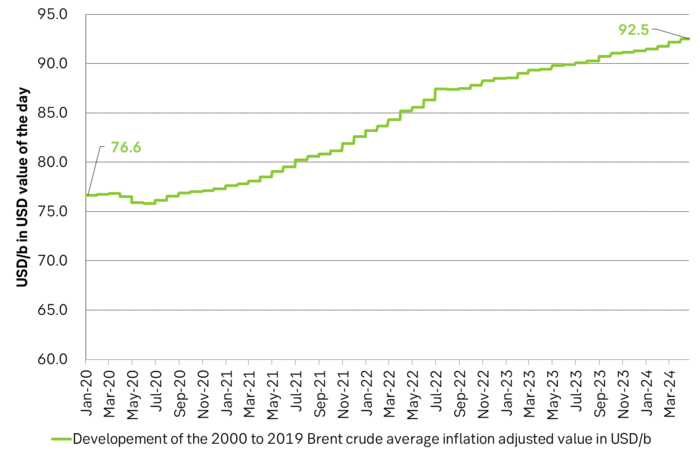
Inflation adjusted Brent crude price versus total US commercial crude and product stocks. A bit above the regression line. Maybe USD 5/b risk premium. But type of inventories matter. Latest big gains were in Propane and Other oils and not so much in crude and products
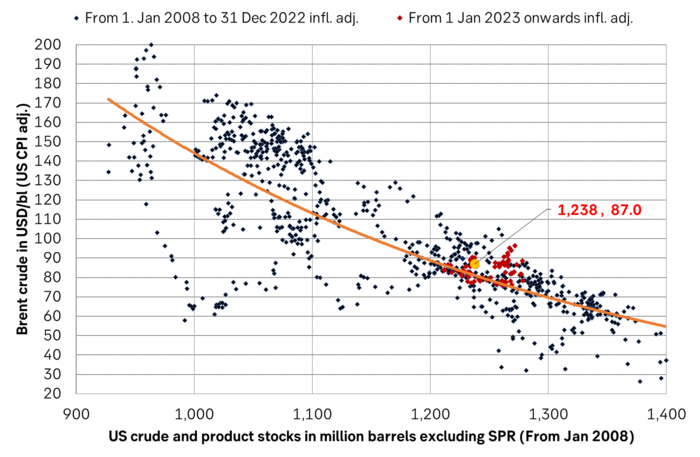
Total US commercial crude and product stocks usually rise by 4-5 m b per week this time of year. Gains have been very strong lately, but mostly in Propane and Other oils

Last week’s US inventory data. Big rise of 10 m b in commercial inventories. What really stands out is the big gains in Propane and Other oils
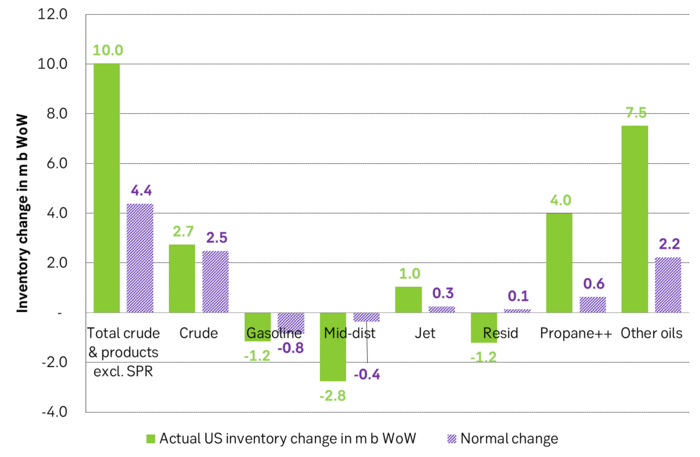
Take actual changes minus normal seasonal changes we find that US commercial crude and regular products like diesel, gasoline, jet and bunker oil actually fell 3 m b versus normal change.
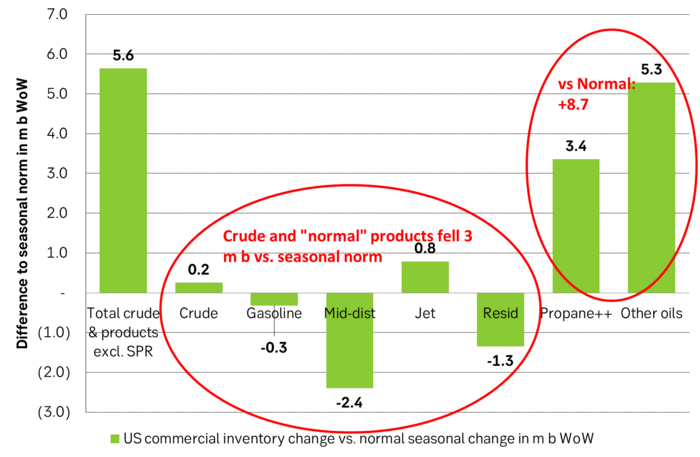
Analys
Nat gas to EUA correlation will likely switch to negative in 2026/27 onward

Historically positive Nat gas to EUA correlation will likely switch to negative in 2026/27 onward

Historically there has been a strong, positive correlation between EUAs and nat gas prices. That correlation is still fully intact and possibly even stronger than ever as traders increasingly takes this correlation as a given with possible amplification through trading action.
The correlation broke down in 2022 as nat gas prices went ballistic but overall the relationship has been very strong for quite a few years.
The correlation between nat gas and EUAs should be positive as long as there is a dynamical mix of coal and gas in EU power sector and the EUA market is neither too tight nor too weak:
Nat gas price UP => ”you go black” by using more coal => higher emissions => EUA price UP
But in the future we’ll go beyond the dynamically capacity to flex between nat gas and coal. As the EUA price moves yet higher along with a tightening carbon market the dynamical coal to gas flex will max out. The EUA price will then trade significantly above where this flex technically will occur. There will still be quite a few coal fired power plants running since they are needed for grid stability and supply amid constrained local grids.
As it looks now we still have such overall coal to gas flex in 2024 and partially in 2025, but come 2026 it could be all maxed out. At least if we look at implied pricing on the forward curves where the forward EUA price for 2026 and 2027 are trading way above technical coal to gas differentials. The current forward pricing implications matches well with what we theoretically expect to see as the EUA market gets tighter and marginal abatement moves from the power sector to the industrial sector. The EUA price should then trade up and way above the technical coal to gas differentials. That is also what we see in current forward prices for 2026 and 2027.
The correlation between nat gas and EUAs should then (2026/27 onward) switch from positive to negative. What is left of coal in the power mix will then no longer be dynamically involved versus nat gas and EUAs. The overall power price will then be ruled by EUA prices, nat gas prices and renewable penetration. There will be pockets with high cost power in the geographical points where there are no other alternatives than coal.
The EUA price is an added cost of energy as long as we consume fossil energy. Thus both today and in future years we’ll have the following as long as we consume fossil energy:
EUA price UP => Pain for consumers of energy => lower energy consumption, faster implementation of energy efficiency and renewable energy => lower emissions
The whole idea with the EUA price is after all that emissions goes down when the EUA price goes up. Either due to reduced energy consumption directly, accelerated energy efficiency measures or faster switch to renewable energy etc.
Let’s say that the coal to gas flex is maxed out with an EUA price way above the technical coal to gas differentials in 2026/27 and later. If the nat gas price then goes up it will no longer be an option to ”go black” and use more coal as the distance to that is too far away price vise due to a tight carbon market and a high EUA price. We’ll then instead have that:
Nat gas higher => higher energy costs with pain for consumers => weaker nat gas / energy demand & stronger drive for energy efficiency implementation & stronger drive for more non-fossil energy => lower emissions => EUA price lower
And if nat gas prices goes down it will give an incentive to consume more nat gas and thus emit more CO2:
Cheaper nat gas => Cheaper energy costs altogether, higher energy and nat gas consumption, less energy efficiency implementations in the broader economy => emissions either goes up or falls slower than before => EUA price UP
Historical and current positive correlation between nat gas and EUA prices should thus not at all be taken for granted for ever and we do expect this correlation to switch to negative some time in 2026/27.
In the UK there is hardly any coal left at all in the power mix. There is thus no option to ”go black” and burn more coal if the nat gas price goes up. A higher nat gas price will instead inflict pain on consumers of energy and lead to lower energy consumption, lower nat gas consumption and lower emissions on the margin. There is still some positive correlation left between nat gas and UKAs but it is very weak and it could relate to correlations between power prices in the UK and the continent as well as some correlations between UKAs and EUAs.
Correlation of daily changes in front month EUA prices and front-year TTF nat gas prices, 250dma correlation.
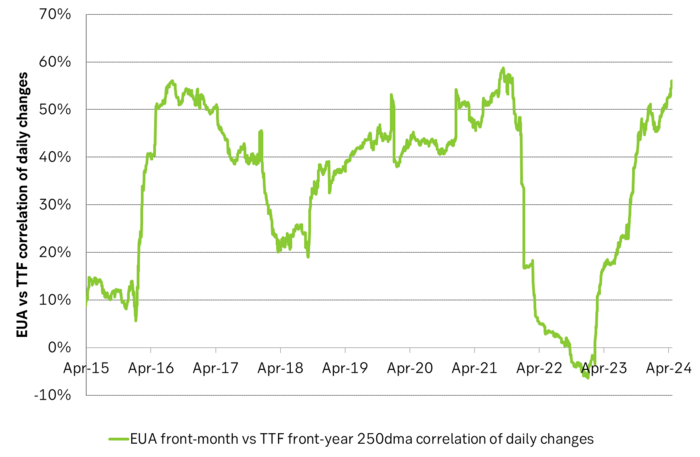
EUA price vs front-year TTF nat gas price since March 2023
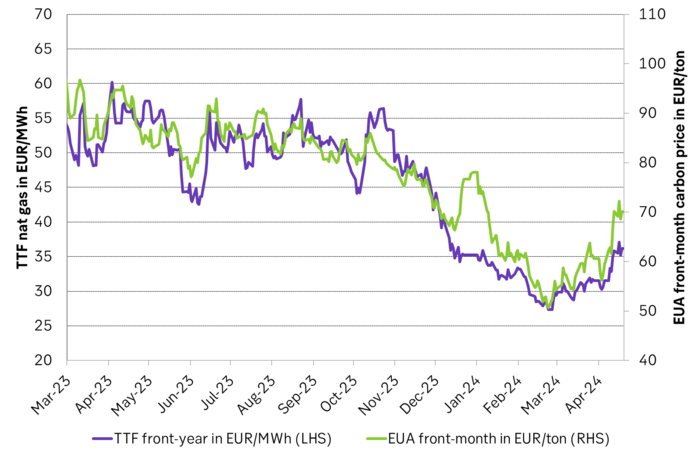
Front-month EUA price vs regression function of EUA price vs. nat gas derived from data from Apr to Nov last year.
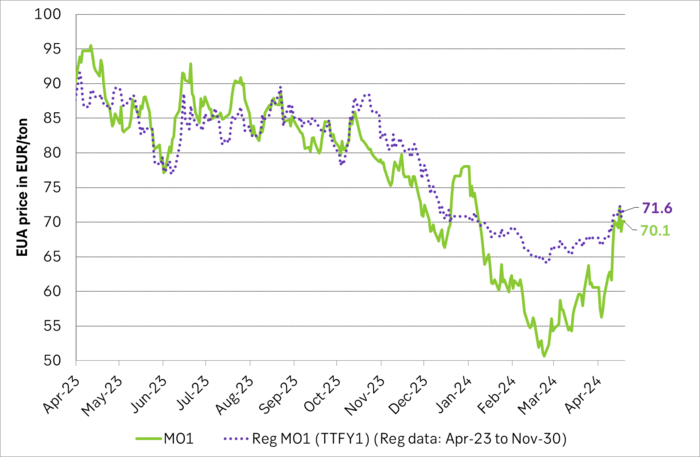
The EUA price vs the UKA price. Correlations previously, but not much any more.
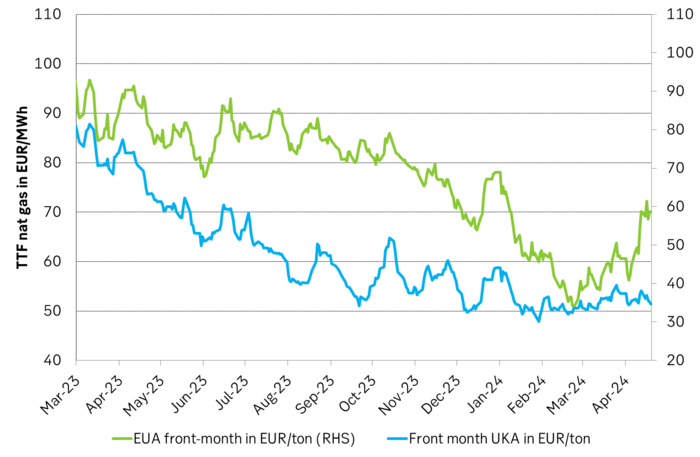
Forward German power prices versus clean cost of coal and clean cost of gas power. Coal is totally priced out vs power and nat gas on a forward 2026/27 basis.
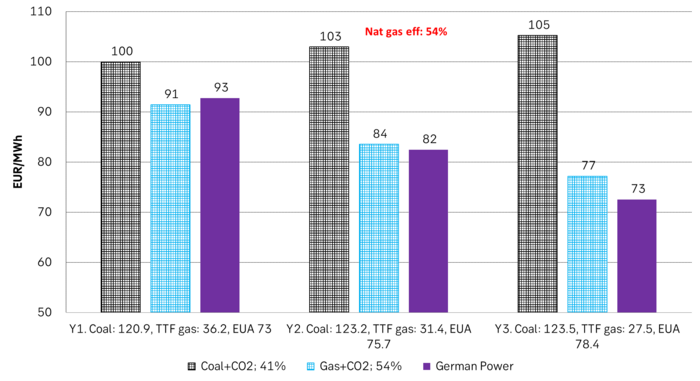
Forward price of EUAs versus technical level where dynamical coal to gas flex typically takes place. EUA price for 2026/27 is at a level where there is no longer any price dynamical interaction or flex between coal and nat gas. The EUA price should/could then start to be negatively correlated to nat gas.

Forward EAU price vs. BNEF base model run (look for new update will come in late April), SEB’s EUA price forecast.
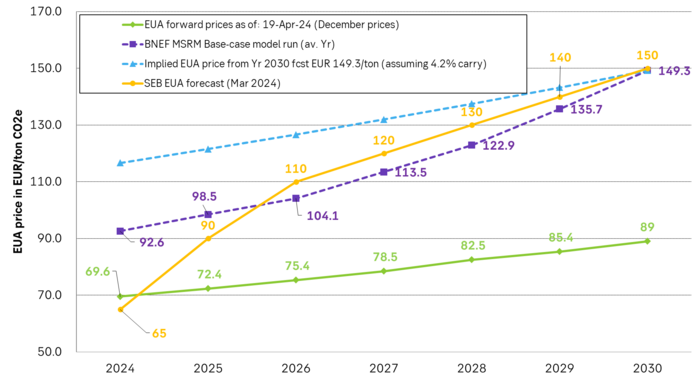
Analys
Fear that retaliations will escalate but hopes that they are fading in magnitude

Brent crude spikes to USD 90.75/b before falling back as Iran plays it down. Brent crude fell sharply on Wednesday following fairly bearish US oil inventory data and yesterday it fell all the way to USD 86.09/b before a close of USD 87.11/b. Quite close to where Brent traded before the 1 April attack. This morning Brent spiked back up to USD 90.75/b (+4%) on news of Israeli retaliatory attack on Iran. Since then it has quickly fallen back to USD 88.2/b, up only 1.3% vs. ydy close.

The fear is that we are on an escalating tit-for-tat retaliatory path. Following explosions in Iran this morning the immediate fear was that we now are on a tit-for-tat escalating retaliatory path which in the could end up in an uncontrollable war where the US unwillingly is pulled into an armed conflict with Iran. Iran has however largely diffused this fear as it has played down the whole thing thus signalling that the risk for yet another leg higher in retaliatory strikes from Iran towards Israel appears low.
The hope is that the retaliatory strikes will be fading in magnitude and then fizzle out. What we can hope for is that the current tit-for-tat retaliatory strikes are fading in magnitude rather than rising in magnitude. Yes, Iran may retaliate to what Israel did this morning, but the hope if it does is that it is of fading magnitude rather than escalating magnitude.
Israel is playing with ”US house money”. What is very clear is that neither the US nor Iran want to end up in an armed conflict with each other. The US concern is that it involuntary is dragged backwards into such a conflict if Israel cannot control itself. As one US official put it: ”Israel is playing with (US) house money”. One can only imagine how US diplomatic phone lines currently are running red-hot with frenetic diplomatic efforts to try to defuse the situation.
It will likely go well as neither the US nor Iran wants to end up in a military conflict with each other. The underlying position is that both the US and Iran seems to detest the though of getting involved in a direct military conflict with each other and that the US is doing its utmost to hold back Israel. This is probably going a long way to convince the market that this situation is not going to fully blow up.
The oil market is nonetheless concerned as there is too much oil supply at stake. The oil market is however still naturally concerned and uncomfortable about the whole situation as there is so much oil supply at stake if the situation actually did blow up. Reports of traders buying far out of the money call options is a witness of that.
-

 Nyheter3 veckor sedan
Nyheter3 veckor sedanGuldpriset når nytt all time high och bryter igenom 2300 USD
-
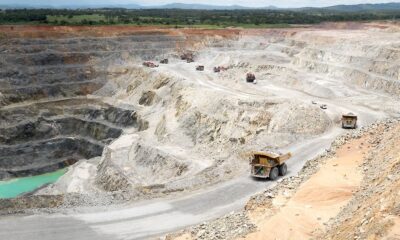
 Nyheter4 veckor sedan
Nyheter4 veckor sedanLundin Mining får köprekommendation av BMO
-

 Nyheter4 veckor sedan
Nyheter4 veckor sedanVertikal prisuppgång på kakao – priset toppar nu 9000 USD
-

 Nyheter3 veckor sedan
Nyheter3 veckor sedanCentralbanker fortsatte att köpa guld under februari
-
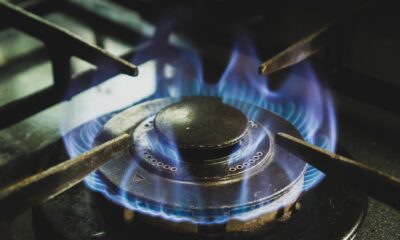
 Nyheter2 veckor sedan
Nyheter2 veckor sedanUSAs stigande konsumtion av naturgas
-

 Nyheter3 veckor sedan
Nyheter3 veckor sedanKakaomarknaden är extrem för tillfället
-

 Nyheter3 veckor sedan
Nyheter3 veckor sedanHur mår den svenska skogsbraschen? Två favoritaktier
-

 Nyheter4 veckor sedan
Nyheter4 veckor sedanBoliden på 20 minuter


